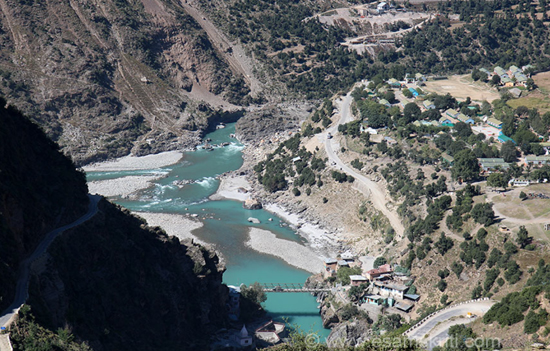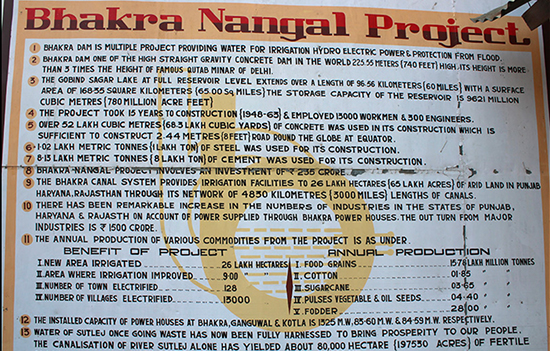- Idea for Punjab to divert surplus waters flowing to Pakistan to itself. Shun Negative Energy. Also is Punjab the Land of Five Rivers today, why is Rajasthan part of Bhakra project, background to the making of Bhakra Dam and when were modern day states of Punjab, Himachal & Haryana created.
As a resident Indian Punjabi who worked in Punjab for three years but no longer lives there read with interest Suresh Kumar’s article BBMB’s foundation lacks federal and legal legitimacy.
The
respected author questions why Rajasthan receives water from Bhakra Nangal Dam
and has equal decision making authority. He also asks for a Government of India
enacted statute dedicated to the management and distribution of the Beas,
Sutlej and Ravi rivers besides a host of legal points.
While
experts can debate legal issues, a bit of background is called for to enable
rational thinking.
Is Punjab the Land of Five Rivers today?
Answer is No. These rivers are Ravi, Chenab, Sutlej, Beas and Jhelum. Their origins -
Sutlej
originates in Tibet and flows through Himachal. Bhakra Dam was built on it. Beas originates from a kund at Rohtang Pass,
Himachal Pradesh. Note that Rajasthan gets maximum water from Pong Dam (Kangra
district of Himachal) i.e. on river Beas. Jhelum
originates from a Kund in Verinag (Kashmir Valley). The Ravi has its source in Kullu hills near the Rohtang Pass in Himachal Pradesh. It enters Punjab Plains near Madhopur.” Source
“The Chenab originates from near the Bara Lacha Pass in the Lahul-Spiti part of the Zanskar Range. Near Kishtwar in UT of J&K, Chenab cuts a deep gorge.” Source Eventually river flows
into Pakistan.
 Right you see river Chenab flowing and from below is Paddar river. Where they join is Bhandarkut Sangam. Pic close to Kishtwar in UT of J&K. 2014
Right you see river Chenab flowing and from below is Paddar river. Where they join is Bhandarkut Sangam. Pic close to Kishtwar in UT of J&K. 2014
The fact that today
these five rivers flow through but do not originate in Punjab needs to be
internalised.
The wheel cannot be turned back.
But
was not Himachal part of Punjab?
We need to know how states of Punjab, Haryana and Himachal come
into being?
Briefly
- In 1954 Bilaspur and Himachal Pradesh united to become a new state. It became
a Union Territory (UT) in 1956. In 1966, Parliament enacted the Punjab
Reorganization Act, 1966 which divided Punjab into Punjab and Haryana and gave
some areas of Punjab to UT of Himachal. In 1971 Himachal Pradesh became a
state.
Why
Punjab and Haryana? Briefly, since 1957 the Akalis started to demand a state
where Punjabi, in Gurumukhi script, would be the state language (linguistic
states was the norm then).
About Bhakra Nangal Dam
 Board at Bhakra Dam. 2014.
Board at Bhakra Dam. 2014.
Bhakra
Dam has its genesis in the 1960 Indus Water Treaty (IWT) where waters of Ravi,
Sutlej and Beas were allotted to India for exclusive use. The river Yamuna that
flows through Haryana is not part of IWT.
Construction of Bhakra Dam resulted
in submergence in large areas of Bilaspur State which became part of the UT of
Himachal in 1954.
The
Nangal dam is on Sutlej at Nangal, Punjab i.e. 13 kms below the Bhakra dam.
Initially
this project was about Sutlej. Later, its scope increased. River Beas (starts in
Himachal) was tapped through Beas project and Ravi through Thein Dam.
The
Ranjit Sagar Dam is located over river Ravi near village Thein in the UT of
Jammu and Kashmir and is the result of a 1979 agreement between Himachal,
Punjab and J&K. The Pong Dam is located on river Beas in Kangra district of
Himachal Pradesh.
Due
to the Punjab Reorganization 1966, operation, maintenance and management of
Bhakra Nangal was handed over to the Bhakra Management Board in 1967. When Beas
River Projects were added to it in 1976 it was renamed as Bhakra Beas Management Board (BBMB). Water and power
allocated to undivided Punjab was partially shared with Haryana on a
pre-determined basis.
Unless the background is understood, rational thinking become difficult. Instead, emotions
could be aroused.
Why is Rajasthan part of the Bhakra Nangal Project?
The
agreement for Bhakra Nangal was entered into in 1959 between states of
undivided Punjab and Rajasthan. It was a joint-venture . The benefits
were to be shared in accordance with their contribution to the cost of the
project. (Answer to Lok
Sabha question no 1327 on 26.11.2007). According to this Indian Express report the “share of Punjab and Rajasthan was to be in the ratio of 84.78 and 15.22.
Domestic
water disputes can be guided, not governed by international law.
Whilst
appreciating the need to look at legal aspects as outlined by Mr Kumar, one
needs to focus on making the pie grow bigger rather than trying to squeeze out
more from the existing pie i.e. Bhakra Nangal Dam.
Here is an IDEA how Punjab can Innovate at little cost
Harike
(near Amritsar) is the Sangam of rivers Sutlej and Beas. From there one line of
water flows towards Ferozepur and thereafter to Pakistan. Another line is to
Rajasthan through the Indira Gandhi Canal while the Gang canal is fed from the Sutlej
near Ferozepur. SO -
Vijay Mohan wrote in Tribune Chandigarh that app 2 Million Acre Feet of eastern rivers
flowed into Pakistan. It was mostly rain or monsoon excess that was beyond the
holding capacity of these rivers and canals and released through the Ferozepur
barrage.
To
reduce or stop water from flowing from Ferozepur into Pakistan the water from
Harike can be directed towards India. Three ways to help Punjab.
One,
desilting and repair (includes lining to reduce seepage) of existing canals
increases their carrying capacity. Two, increasing the carrying capacity of
canals that take water to Rajasthan. Three, build new canals to take water to
Punjab.
If
Punjab had a dynamic government, it could have prepared a plan to prevent water
from flowing into Pakistan and transfer such water to itself. A nationally
televised concrete plan could have positioned it as a National Project and
sought 100% government of India funding. Modi Sarkar would find it very
difficult to refuse!!
Sadly,
state governments cutting across political parties only talk of free power (Rs
6,947 crs). The proposed power subsidy bill in FY23 is Rs 15,845 crs. This and other freebies leaves fewer resources for needy programs in an
agrarian state. Also read RBI
Report on State Finances-Punjab worst hit
Free power has hurt Punjab’s agriculture, depleted water resources by encouraging paddy cultivation, added to farmers’ production cost by forcing the installation of submersible pumps and curtailed industrial activity during the paddy season but who will stop it.
Punjab
needs a leader who thinks beyond vote-bank politics and stops farmer appeasement
whilst addressing genuine concerns. If Punjab fails, it would be a sad day for
Punjabis worldwide, a community that successfully rebuilt its life post
Partition.
It is easy to blame others but difficult to look within, reflect
and change.
Author is an
Independent Columnist, Chartered Accountant whose Dr Nana practiced in Abohar from
1932-1972 & Ma passed out from Amritsar Medical College.
References and Read
1.
Water-sharing dispute between Punjab and Haryana – What happened why
2.
Erstwhile State of Punjab and Rajasthan collaborated in construction of Bhakra-Nangal Project in 1948. According to Sub-section 5 of Section 79 of Punjab Reorganization Act, the Governments of successor States of the erstwhile Punjab and the State of Rajasthan are required at all times to provide necessary funds to the Bhakra Beas Management Board to meet all expenses required for the discharge of its functions.
3.
Decoding
Suspension of Indus Water Treaty
4.
Why was Bhakra
Nangal Dam made?
5.
Is Punjab the Land
of Five Rivers?